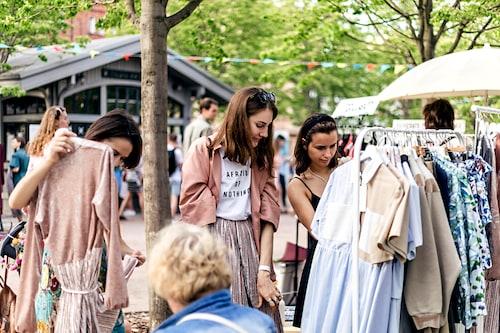The unstoppable rise of secondhand fashion
A new report confirms the appeal of secondhand clothing to younger generations, and shows that inflation has had no impact on the market's growth, quite the contrary


Valued at an estimated $177 billion in 2022, the global secondhand fashion market is expected to nearly double by 2027 to reach $350 billion. A new report confirms the appeal of secondhand clothing to younger generations, and shows that inflation has had no impact on the market"s growth, quite the contrary.
Along with clothing rental and repair, secondhand has emerged as one of the fashion industry"s new ways of addressing the climate emergency. But the resale market seems to stand above the rest, and is even becoming an established part of shoppers" habits around the world. The latest report from thredUP, conducted in partnership with analysts GlobalData, suggests that the global secondhand fashion market is expected to double by 2027 to $350 billion.
Despite pressure from inflation, the secondhand market has seen growth jump by 28% in 2022, and forecasters estimate that the global clothing resale market could grow three times faster than the overall clothing market. This explains why many in the fashion industry are now heading into this segment, from luxury labels to ultra-fast fashion retailers and traditional ready-to-wear brands. Secondhand clothing represents a significant financial boon for the industry, with 10% of the global clothing market expected to be made up of secondhand clothing by 2024, this new report reveals. It also states that the retailers launching into this field are doing so to attract more customers, be more eco-responsible, and increase their revenues.
Supplemented by a survey of more than 3,000 US adults over the age of 18, the report shows that more than one in two consumers (52%) purchased secondhand clothing in 2022, despite financial pressure from soaring prices in the United States. Not only is inflation not holding back this booming market, but it is even proving to be a driving force in the eyes of consumers, who no longer (solely) see this way of shopping as a means to buy more responsibly. Nearly four out of ten respondents (37%) say they spent more of their clothing budget on secondhand clothes last year, and almost as many (42%) believe that secondhand clothing has become more accessible. Furthermore, the report reveals that consumers plan to spend a greater share of their clothing budget on secondhand items in 2023.
While price remains a significant incentive for Generation Z, as it is for Millennials, these two environmentally aware generations also see it as a way to reduce the ecological footprint of their wardrobes. More than half of them (58%) are aware that their wardrobe contributes to climate change, and nearly two-thirds (63%) that they can reduce their footprint as individuals. As a result, 47% of Gen Z refuse to buy from unsustainable clothing brands and retailers, and 83% have already purchased or plan to purchase secondhand clothing.
*In addition to data from GlobalData (consumer surveys, retailer tracking, official public data, data sharing, etc.), the report is based on a survey also conducted by GlobalData in December 2022 of 3,012 US adults over the age of 18.
First Published: Apr 07, 2023, 12:50
Subscribe Now